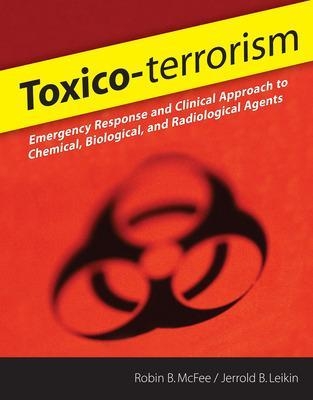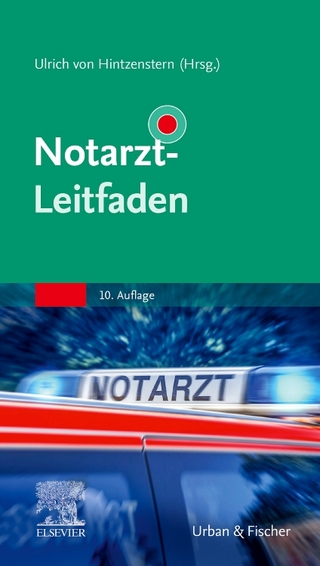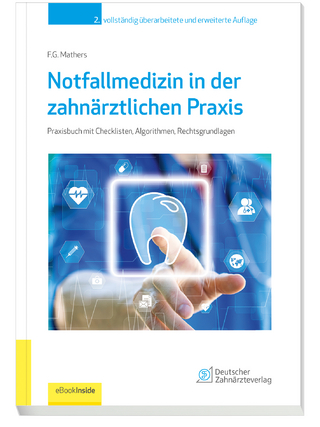
Toxico-terrorism: Emergency Response and Clinical Approach to Chemical, Biological, and Radiological Agents
McGraw-Hill Medical (Verlag)
978-0-07-147186-2 (ISBN)
- Titel z.Zt. nicht lieferbar
- Versandkostenfrei innerhalb Deutschlands
- Auch auf Rechnung
- Verfügbarkeit in der Filiale vor Ort prüfen
- Artikel merken
Publisher's Note: Products purchased from Third Party sellers are not guaranteed by the publisher for quality, authenticity, or access to any online entitlements included with the product.
The emergency medicine expertise you need to prepare for--and manage--any type of bioterrorist attack!
Written by emergency room physicians for emergency room physicians, Toxico-terrorism covers every essential aspect of the emergency medical response to microbial, radiological, and chemical agents of terrorism. Turn to any page, and you'll find lifesaving clinical strategies for the management of patients who have been exposed to a biologic, chemical, or nuclear agent.
Features
A logical, building-block organization filled with key tables and synoptic boxes
Important coverage of pre-hospital and EMS issues
Insights into the means of transmission, the modes of dispersal, and how secondary infection and/or contamination can occur
Overview of bioterror-specific signs and symptoms
A section on emergency department preparedness that reviews critical topics such as nursing triage, hospital/facility security, pharmacy preparedness, and hospital staff issues
Up-to-date information on labs, microscopy, and radiology
Key diagnostic criteria for all agents
Thorough coverage of treatment strategies for all agents discussed in the book
Infection control modalities
Survey of prophylaxis strategies
Valuable section on public health considerations
Robin B. McFee, DO, MPH, FACPM, Assistant Professor, Department of Preventive Medicine SUNY/Stony Brook Assistant Professor, Department of Medicine NYCOM, New York Institute of Technology Toxicologist, Long Island Regional Poison Information Center Winthrop University Hospital Mineola, New York Medical Director, Threat Science Jerry B. Leikin, MD, FABMT, FACEP, FACMT, FAACT, FACOEM, Director of Medical Toxicology Evanston Northwestern Healthcare--OMEGA Glenbrook Hospital Glenview, Illinois Professor of Emergency Medicine Feinberg School of Medicine Northwestern University Professor of Medicine, Pharmacology, and Health Systems Management Rush Medical College Chicago, Illinois
Part I: General Patient Principles1. Toxidrome Recognition2. Biodromes--Bioweapon Recognition 3. Countermeasures and Facility Preparedness: An Overview 4. Supportive Care5. Dermal Issues6. Neurological Issues in Emergency Bioterrorism7. Cardiac Issues 8. Musculoskeletal Manifestations of Bioterrorism9. Ophthalmological Issues10. Respiratory and Critical Care Unit Issues11. Gastrointestinal and Hepatic Issues12. Acute Psychiatric Issues13. Palliative and Expectant (Black Tag) Care14. Special Populations: Pediatrics15. Geriatrics: Bioterrorism, Emerging Threats, and Emergency Preparedness: Special Considerations for Geriatric Patients16. Special Populations: Women Who are Pregnant17. Women's Reproductive Issues18. Hospital Laboratory Issues Part II: EMS Issues19. Chempack20. Approach to Disaster and Mass Casualty Incidents21. Hazardous Materials (Hazmat) Emergencies22. Enhancing Hospital Emergency Preparedness23. EMS-ED Considerations24. Field Identification and Decontamination of ToxinsPart III: Emergency Department Preparedness25. Triage in the Emergency Department 26. Pharmacy Preparedness for Incidents Involving Nuclear, Biological, or Chemical Weapons 27. Hospital Staff IssuesPart IV: Specific Chemical Agent: Toxins/Toxicants28. Nerve Agents29. Blister Agents30. Chemical Asphyxiants31. Flammable Industrial Liquids and Gases32. Corrosive Industrial Agents33. Arsenic, Lead, and Mercury34. Pulmonary Agents35. Pesticides36. Nonlethal Weapons or Incapacitating Agents37. Other Chemical AgentsPart V: Biologicals38. CDC Category Explanation (A,B,C) Overview39. Anthrax40. Yersinia Pestis--Plague41. Botulism42. Smallpox (Variola) and Poxviruses43. Tularemia44. Hemorrahagic Fever 45. CDC Category B Agents 46. CDC Category C Agents47. Emerging Pathogens48. Avian Influenza 49. SARS: Severe Acute Respiratory Syndrome50. AgroterrorismPart VI: Ionizing Radiation 51. A Practical Basis for Early Management of Radiologically Injured or Ill Patients: Ionizing Radiation Physics and Instrumentation, Radiation Protection, Contamination Control, Dosimetry, and Radiological/Nuclear (R/N) Terrorism52. Diagnosis and Medical Management of Radiation Injuries and IllnessesPart VII: Explosives/Incendiaries53. Medical Management of ExplosivesPart VIII: Public Health Considerations54. Poison Information Centers55. Biosurveillance56. VaccinesAppendicesA. CDC Chemical Emergencies: OverviewB. CDC Laboratory Preparedness for Emergencies: Response to Suspicious SubstancesC. CDC Laboratory Preparedness for Emergencies: Facts about the Laboratory Response NetworkD. CDC Laboratory Preparedness for Emergencies: Laboratory Network for Biological TerrorismE. CDC Specimen-Collection Protocol for a Chemical-Exposure EventF. Centers for Disease Control and Prevention Shipping Instructions for Specimens Collected from People Who May Have Been Exposed to Chemical-Terrorism Agents: Collecting SpecimensG. Continuation Guidance--Budget Year Four, Focus Area D: Laboratory Capacity--Chemical AgentsH. Instructions for Shipping Blood Samples to CDC after a Chemical-Exposure EventI. Instructions for Shipping Urine Samples to CDC after a Chemical-Exposure EventJ. Sentinel Laboratory Guidelines for Suspected Agents of Bioterrorism: Clinical Laboratory Bioterrorism Readiness PlanK. Riot Control AgentsChlorine Use as a WeaponIntentional Use of Radiation as a Weapon
| Erscheint lt. Verlag | 16.9.2007 |
|---|---|
| Zusatzinfo | 60 Illustrations, unspecified |
| Verlagsort | New York |
| Sprache | englisch |
| Maße | 216 x 274 mm |
| Gewicht | 1422 g |
| Themenwelt | Medizin / Pharmazie ► Medizinische Fachgebiete ► Notfallmedizin |
| Sozialwissenschaften ► Politik / Verwaltung | |
| ISBN-10 | 0-07-147186-3 / 0071471863 |
| ISBN-13 | 978-0-07-147186-2 / 9780071471862 |
| Zustand | Neuware |
| Haben Sie eine Frage zum Produkt? |
aus dem Bereich


